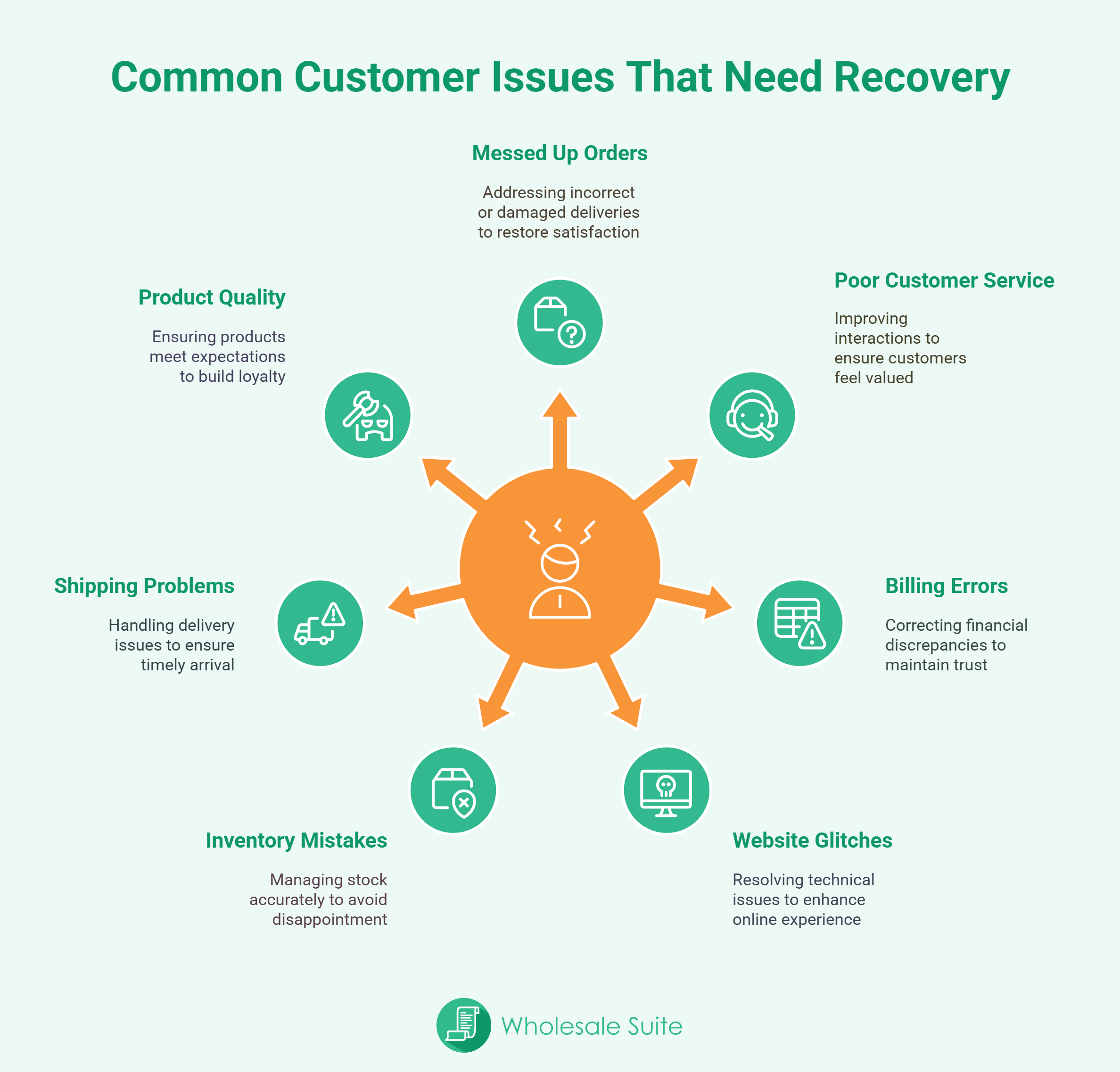Sometimes, things do not go as planned. A package gets lost, the wrong item is delivered, or someone is double-charged. These are all examples of messed up orders and other problems that can upset customers. When that happens, what you do next is what really matters. This is where customer recovery comes in.
If customer recovery is handled effectively, it can transform a negative experience into a more positive one. In some cases, it can even build stronger customer loyalty than if the problem had never happened.
In this article, we will walk through common problems like messed up orders, customer service mistakes, and billing issues. You will see helpful examples and tips to guide your team whenever things go wrong.
Let’s start by understanding what customer recovery is and why it should be part of every store’s process.
What Is Customer Recovery?
Customer recovery is the process a business undertakes after an issue arises. It is how you respond when a customer has a bad experience. This can happen when someone receives the wrong product, gets overcharged, or feels ignored by support. The goal of customer recovery is to fix the issue and make the customer feel heard, respected, and valued.
Let us say a customer receives a broken item. A weak response would be to just say “sorry” and send a refund. However, a strong recovery plan considers the entire situation. You replace the item quickly and give the customer a clear update. You maybe even include a small gift or coupon to say sorry in a real way.
Why is it important?
Good customer recovery builds trust. It helps customers feel safe buying from you again. When a store acknowledges a mistake and rectifies it properly, that creates a better customer experience. People do not always expect perfection. But they do expect fairness and care. That is why customer recovery is not just about solving the problem. It is also about showing your values.
When businesses ignore or downplay messed up orders, it damages their reputation. Customers may leave bad reviews. They may stop coming back. On the other hand, if you recover well, many customers actually stay loyal. Some even talk about the good recovery more than the mistake itself. This is how customer satisfaction can still grow, even after something goes wrong.
Common Customer Issues That Need Recovery
Not every sale goes smoothly. Problems can happen at any point, and when they do, you need a solid customer recovery plan. The good news? Many customer issues follow the same patterns. If you know what to look out for, it’s easier to fix things fast and keep customers happy. Here are some of the most common issues that call for good service recovery:
1. Messed up orders
This is one of the most common and frustrating problems. These include receiving the wrong item, packages arriving damaged, orders showing up late, and missing items in the box. These messed up orders can leave customers feeling disappointed or even angry.
2. Poor customer service
Even when the product is fine, bad service can ruin the whole experience. A person might ask for help and get a rude answer. Or they might wait days for a reply that never comes. Common signs of poor service include unfriendly or cold responses, no updates while waiting, and different agents saying different things. When this happens, customers often feel ignored. Good customer recovery means not just solving the problem, but making the person feel like they were treated with care.
2. Billing errors or pricing problems
Money mistakes can create big trust issues. When a customer sees a wrong charge or does not get their discount, it causes stress. Common billing problems are being charged twice, discount codes not applying, wrong totals at checkout, and refunds taking too long. These mistakes should be addressed promptly. Effective service recovery in billing demonstrates to the customer that you value fairness and their time.
💡Tip: One way to avoid these types of billing issues is by using reliable payment tools that connect smoothly with your store. If you run a wholesale business, using Wholesale Payments can help reduce errors and clarify processes for both you and your customers. It helps you collect payments easily, keep billing records straight, and support different payment terms without confusion.
3. Website or system glitches
Sometimes the problem starts before the sale even happens. A customer might attempt to place an order, but the website is not functioning. Or they get charged even though the page crashes. These issues include failed payments, items disappearing from the cart, trouble logging in, and mobile checkout not working. These problems may seem technical, but they still impact the customer experience. So even if the issue is with the system, your support team should lead the customer recovery.
4. Inventory or stock mistakes
This occurs when an item is listed as “available,” but it is actually unavailable. Or when someone pre-orders something that gets canceled. The customer made plans based on that order, so now they are upset. These situations require fast action and clear answers. If not, they can lead to lost trust and low customer satisfaction.
5. Shipping or courier-related issues
Even if you pack everything correctly, outside factors can still affect delivery. A late or lost package still feels like your fault to the customer. Common shipping issues are no tracking updates, wrong delivery address, or a package marked “delivered” but not received. This is where your customer service makes all the difference. You need to take ownership and offer a recovery option, even if the shipping company is to blame.
6. Product quality complaints
A product might arrive just fine, but it does not meet expectations. It might look different from the photos. It might break after just one use. The listing might be clear, but the customer experience still feels bad. In these cases, customer recovery means being open to feedback and offering the right solution.
Methods To Make It Up To Your Customer
Apologize
If you mess up your client’s order, do not plan the apology for another more convenient moment. And when you say it, do not mumble it under your breath, no. Apologize and mean it.
When you realise that a mistake has occurred, make sure the first thing that comes out of your mouth is an outright, “I am sorry”. When an apology is the first thing that comes out of your mouth, it helps your situation.
If you are apologising to your customer via email or letter, ensure that your apology comes first. Also, end your letter or email with another full apology. For instance, you can sign off your letter or email with a statement like, “Once again, I apologise for any inconveniences caused.”
Explain
The next thing that you should do after your apology is to give a full explanation of what exactly happened.
Explain in detail the mistake that you made. Tell your client whether it was a system error or if it was a mistake made by you or your staff. Whatever caused the mess, this is your chance to make things right. As the business owner, it falls to you to assume responsibility for everyone in your company, including the system that you are using.
You have to give a detailed explanation. It might be lengthy but it will help your client understand what went wrong if they have all the details. Be careful not to include unnecessary internal drama your company might be having.
Transparency
After making a mistake, you can build your customer’s confidence in you if you are transparent to them.
An example would be if your client placed an order and you are not able to deliver it within the agreed time frame. Ensure that you contact your client and let him know the situation in advance.
Updating your customer with what you are doing to solve the problem can help keep your customers. It will also show that even after making a mistake, you still have their interest at heart.
Take responsibility
The next thing to do to make it up to your customer and accept responsibility.
Even if one of your employees caused the error or it was a system error, you as a business owner should take the responsibility. You may not be directly to blame for the mistake that occurred but you are responsible for your business. All your staff and systems included and you need to try to make it right.
Empathise with your customer
If you mess up your customer’s order, chances are that your client is most likely frustrated. They might also be hurt, angry and they might be regretting ever placing an order from your company.
Put yourself in your client’s shoes and reflect. Let your customer know that you understand their feelings. Though you can never know exactly what your customer is feeling, you should try to empathise with them.
Try to work out a win-win solution where you can extend a hand of goodwill to help the customer tide over whatever inconveniences your mistakes have caused.
Reassure your customer that it will not happen again
After everything has been said and done, you need to reassure your client that you have the situation under your control. Explain to your customer the measures you have put in place to ensure that such a mistake will not occur again.
You also have to assure your customer that you have learned from the experience. You should be careful not to put your business in a negative light which can turn your clients away. Explain everything with a lot of positivity.
Examples Of Good Customer Recovery Responses
When something goes wrong, what you say matters just as much as what you do. A good customer recovery message can calm an upset customer, fix the issue clearly, and rebuild trust. The way you respond should feel kind, simple, and personal. Here are some sample replies you can use during different situations.
Sample message for a messed up order
Hi (Customer Name),
We’re very sorry about what happened with your order. You expected (correct item), but we sent the wrong one. That’s our mistake. We are already preparing the correct item and will ship it out today. You’ll receive tracking details shortly.We’ve also added a small coupon to your account as a gesture of apology. If you have any other concerns, we’re here to help.
Thank you for your patience,
(Your Team Name)
This kind of message shows you understand the issue. It clearly explains the next step and makes the customer feel heard. That’s what good customer service recovery looks like.
Sample message for delayed support
Hi (Customer Name),
Thanks so much for reaching out. We apologize for the delay in getting back to you. We understand that waiting for help can be frustrating.We’ve looked into your concern and here’s what we found: (insert answer). If there’s anything we missed, just let us know. We’ll make it right.
We appreciate your time and patience. You’re important to us.
All the best,
(Your Team Name)
Even a simple delay can turn into a negative experience if there’s no follow-up. But with a message like this, you’re offering support, not excuses.
Sample script for refund issues
Hi (Customer Name),
Thanks for letting us know about the billing issue. You were right. Your order was charged twice, and we’re correcting the issue now. The extra charge has been refunded, and it should reflect on your account within X business days.We’re genuinely sorry for the trouble this caused. If you have any questions, please don’t hesitate to reply to this email. We’re here to make sure your customer experience stays smooth moving forward.
Sincerely,
(Your Team Name)
Money mistakes can quickly damage customer satisfaction, but with fast action and clear updates, you can fix the issue and restore trust.
Using messages like these not only helps with service recovery, but it also builds better customer loyalty over time.
Tips For Building A Stronger Customer Recovery System
Mistakes will happen. But how your business handles them makes all the difference. A good customer recovery process does not have to be complicated. It just has to be thoughtful, consistent, and ready when things go wrong. Here are some final tips to help you build a stronger recovery system that improves customer satisfaction and protects customer loyalty.
Train your team
Your team should know how to spot problems and respond with care. Every support agent, warehouse staff, and even your salespeople should understand the basics of customer service recovery. A kind reply or a fast solution can turn a bad situation around. Training also helps your team feel more confident when dealing with upset customers.
Have backup plans
Sometimes, a simple refund or replacement is not enough to resolve the issue. You need a backup plan for issues such as repeated shipping problems, stock errors, or negative reviews. Having options ready, such as sending a faster courier or offering store credit, shows that you care about the entire customer experience, not just the sale.
Don’t wait for mistakes to escalate
The longer you wait, the worse the problem feels for the customer. If you notice a delay or issue early, reach out first. This shows customers that you are paying attention. Early replies often prevent a small mistake from becoming a big one. Quick action is a crucial component of effective service recovery.
💡Note: One way to achieve this is by using tools that help you respond more quickly. If your store receives a high volume of product questions, using a tool like Product Questions Agent AI by StoreAgent can be helpful. It answers common product questions for you, so your team can focus on more serious issues.
Learn from repeated issues
If the same problem keeps happening, it’s a sign to look into it further. Are people often reporting messed up orders? Are refund requests getting stuck? Use this information to improve your system. Fixing the root cause helps reduce future mistakes and makes customer recovery easier for your team.
Other Related Articles
Frequently Asked Questions
What are the factors involved in customer recovery?
Several things affect how well customer recovery works. First, timing is important. You should respond as soon as you can. Second, the tone of your message matters. A kind and respectful tone can calm down even an upset customer. Third, your solution needs to be fair. This might mean sending a replacement, giving a refund, or offering store credit. Lastly, follow-up is helpful. Reaching out after the problem is fixed shows that you care about the full customer experience.
What is the most important part of the customer recovery process?
The most important part is how you make the customer feel. Even if the problem was fixed, a cold or delayed reply can leave a bad memory. But a fast and thoughtful reply can turn a negative experience into a positive one. That is why your customer service recovery message should be honest, personal, and clear.
Why is service recovery important?
Service recovery is important because it helps protect your brand. It also builds trust and keeps your customers coming back. People understand that mistakes happen. What they care about is how you respond.
If your business has no plan for customer recovery, even small issues can lead to bad reviews, refunds, or lost sales. But if you recover the right way, you can still earn high customer satisfaction and long-term customer loyalty. A strong service recovery plan helps you keep customers even after something goes wrong.
Key Takeaways
Running a store means things can go wrong sometimes. A product might be damaged. A customer may be charged the incorrect amount. A delivery might not show up. These are all examples of messed up orders and other service mistakes. However, what matters most is this: with the right customer recovery steps, you can resolve these issues in a way that keeps the customer satisfied.
Here’s a recap on what we discussed about customer recovery strategies:
- What is customer recovery
- Common customer issues
- Methods to make it up to customers
- Recovery responses template
- Final tips
So remember, customer recovery is not just a backup plan. It is part of what makes a good store great. When you take action, own the mistake, and show the customer that they matter, you do more than save the sale. You build trust. And in today’s world, trust leads to stronger customer satisfaction, better reviews, and more loyal customers.
Do you have other questions regarding customer recovery? Let us know in the comments!










All that is nice but none of that is good enough to keep their business. You better offer a big discount if you want to keep them around.
I disagree that you need to offer a discount for them “to keep around”. If all of the above tips are performed a customer will stick around, they will understand that we are all human and errors can happen. You only need to offer discounts if you are unable to provide great customer service.
I agree with both of you actually. Discounts have their place as a customer service tool but aren’t required to get the job done to keep them around.
Dude when I screw up paying a bill I’m charged a extra fee, if I over draft it’s a fee, if your broke and need a payment plan it’s a extra fee. Sorry but when a company, especially big company or heart corporation makes a mistake I dan. Sure want a big discount or make them pay some sort of fee for inconveniencing me, wasting my time, or providing false info. I never blame the poor pawn that has to deal with C.C. but I sure as hell blame the “system” cause they write the playbook so when its thier turn to F****** up you better believe I want them to pay up. Because my time is money and I’m wasting it on thier 1800 number or sending emails back on front.
Can you help me, how to respond to the customer who make wrong order and the order already completed. We sent the items and billed them. But they said “Please let me know what I can do to assist in correcting this.” when things cannot be undone. Help me.. I need to response them politely. Thank you
Hi Fad, if you’ve already shipped the items then its common for the customer to wear the cost of returning the items to you. Only big companies like amazon are able to eat the cost of transporting a refunded item back, especially on larger orders.
If you don’t have a refund policy, now is a good time to sort one out.
I preserve wedding bouquets in resin. I am very new to this and my customers know that. There is an imperfection in one piece and I want to of course apologize and explain what happened, and also offer them another piece at no cost to them. Please help!
ADG – when in doubt, do what you would want as a consumer. Sounds like you’re on the right path.
I think the customer should receive an apology and explanation in addition to some sort of compensation. The situation is not a friendship where an apology and explanation can help to right the wrong. It is a business arrangement. If any part of the arrangement becomes flawed, then the initial agreement is null and void. Additional steps should immediately be taken by the merchant to try and mend the issue. After-all the customer is STILL PAYING for the service or item/s. Even if they cancel the order, they should be compensated for the time and headache the issue has caused. Just as someone said above, if we the customer fail to make a payment for a service or extended pay plan, we cannot simply apologize for our forgetfulness. There is always a late fee or some sort of punishment for the mistake. So…. turn around is fair play. In other words…compensate the customer in some way to demonstrate your appreciation that they chose your business above others in the beginning and that their future business is important to your establishment.